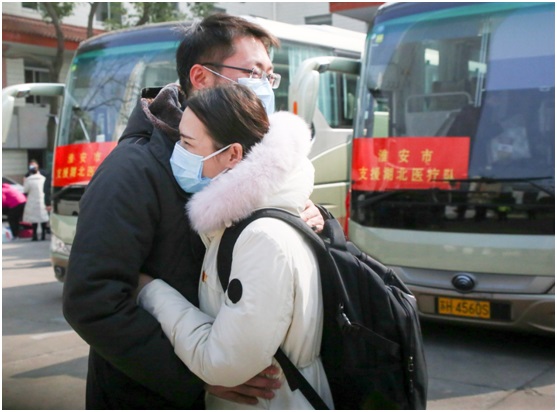By People’s Daily
Nearly 6,000 medical stuff from over 10 provinces in China arrived at the Wuhan Tianhe International Airport in epicenter Wuhan, central China’s Hubei province on Feb. 9, marking the largest single-day number of medics’ arrivals at the airport since the outbreak of the novel coronavirus.
A total of 41 aircraft landed at the airport that day, from 1:50 a.m. to 23:50 p.m.
The 8th batch of medical staff sent by east China’s Shandong province was among the 6,000 medics. The medical team has 303 staffs coming from 153 hospitals across the province, and they are deployed at the “Fang Cang” shelter hospitals converted from gymnasiums, exhibition centers and sports centers in Wuhan.
Before their departure, Liu Yongtao, head of the medical team, stressed that members on the team must take extra care while working in Wuhan. “Fang Cang hospitals are built to treat patients with mild symptoms, but the large number of patients there would pose a huge challenge for quarantine and protection,” Liu explained.
So far, nearly 20,000 medical staff have been sent to Hubei to treat patients, and those working in the worst-hit areas are all elites from across the country.
Wuhan is a key region for epidemic prevention and control, but the number of infections is still on a rise in several surrounding prefecture-level cities. These cities, facing a severe shortage of medical resources and less attention from the society, have successively run out of relief materials, and some even asked for emergency rescue.
On Feb.7, a special mechanism body on fighting the novel coronavirus outbreak under the State Council, China’s cabinet, held a news conference, introducing a national “pairing-up support for Hubei” policy launched by the National Health Commission (NHC) that aims to increase medical supplies and better satisfy patients’ demands in non-capital cities of the province.
Under the mechanism, 16 cities in Hubei province have been partnered with a province or municipality that will offer assistance.
The targeted assistance will ease the pressure of epidemic control through national efforts, meet the urgent need of Hubei and curb the spread of the virus as fast as possible. Besides, it can also integrate medical resources inside and outside the province and improve the 16 cities’ medical competence in a short period of time.
The “pairing-up support for Hubei” policy triggered huge sensation on Chinese social media where netizens from Hubei extended their appreciation to the nation and received strong supports from the people in the rest of the country. Such warmth is a token of the brotherly ties of the Chinese people.
This is not the first time for China to introduce partner assistance. After a major earthquake struck Wenchuan, Sichuan province in 2008, Chinese provinces and municipalities including Beijing, Guangdong, Shandong and Zhejiang responded immediately, and helped the people there rebuild their home on the ruins.
Besides, in the nationwide poverty alleviation campaign, eastern and western provinces and regions collaborated with each other, while government departments, enterprises and public institutions at all levels teamed up with assigned impoverished regions. Under such mechanism, poverty-stricken areas across the country received abundant assistance in human resource, finance and materials.
Facts proved that partner assistance is an effective strategy in the face of major tasks. The whole set of mechanisms is aimed at overcoming difficulties with nationwide efforts, which reflects China’s leading position in governance.
Concentrating efforts on major tasks is a significant advantage of the Chinese political system and the national governance system, and also a forceful weapon to win the battle against the epidemic.
With the rapid development of the virus, the entire nation is mobilized to join the prevention and control of the epidemic. In this war where failure is not tolerated, victory is waiting ahead as long as greater strength is gathered and more solid efforts made.
On Feb. 9, a man sees off his wife in Huai’an, east China’s Jiangsu province, before the woman, who’s among the second batch of medics sent by the city to Hubei, departs for the epicenter to help epidemic control and prevention there. Photo by Wang Hao, People’s Daily










Leave a Comment